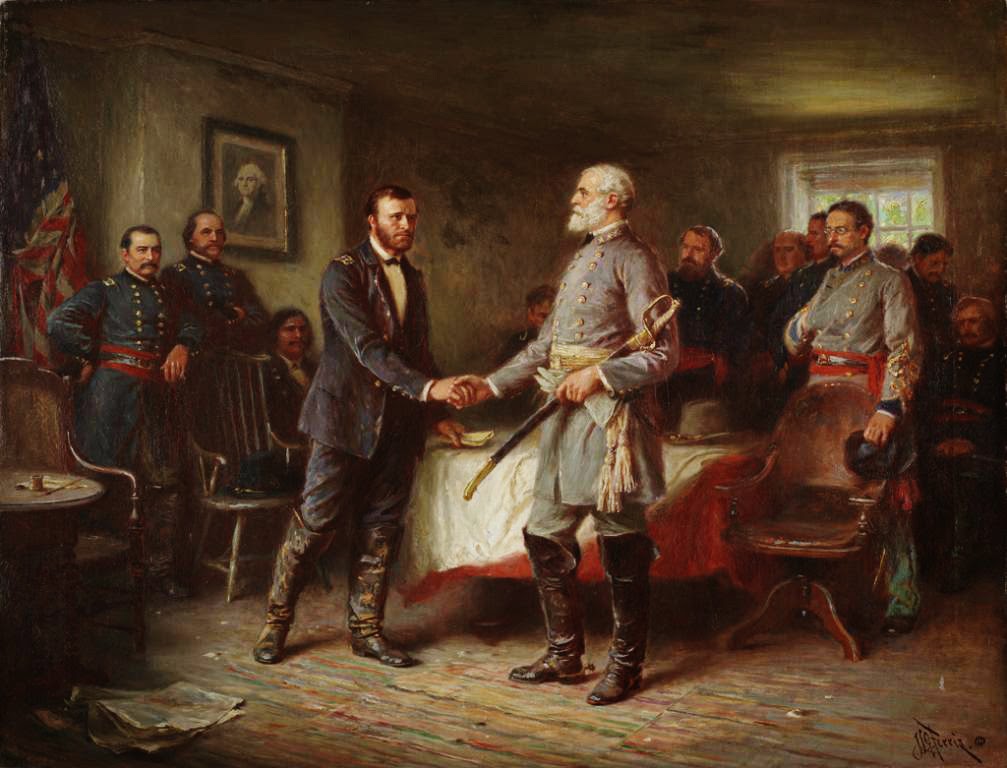About Publications Library Archives
heritagepost.org

Preserving Revolutionary & Civil War History

Preserving Revolutionary & Civil War History

When Grant broke his lines around Petersburg on April 2nd and Lee put his army into retreat, his plan was to keep ahead of the Federals and join Joseph Johnston’s army in North Carolina. He was very low on supplies, so he would have to resupply his army along the way. He pushed his men hard to make it to the supplies that were suppose to be waiting for him at Amelia Court House.
When he arrived there on April 4th, his exhausted men having marched all day and night, he found that ammunition had been sent from Richmond instead of food. The little thath ad been traveled by wagons had been captured by Phil Sheridan’s cavalry which had been hard on the Confederate heels. The rebels couldn’t eat gunpowder, so Lee had to halt his army for a day to forage for what supplies they could find in the countryside, allowing Grant to catch up. Lee continued to push his army forward, but his prospects grew darker and darker. The federal cavalry was pressing at the army’s heels, but LEe didn’t have the time, nor strength to halt to beat them back.
On April 6th, disaster struck in what is called the Battle of Sailor’s Creek. Some Confederates were delayed in their march by having to fend off the pursuing Federals, and so a gap developed in the Confederate column. Eventually, the corps of Anderson and Ewell were separated and brought to bay. Surrounded by Grant’s army, their men were either captured, or scattered. When he say the broken remnants of Anderson’s corps fleeing the field, Lee exclaimed…
“My God, has the army dissolved?” “No, General,” Major General William Mahone replied, “here are troops ready to do their duty.”
The rebels were headed for Appomattox Station, where they could get the supplies they desperately needed. However, on April 8th, the Union cavalry arried there first, and captured the food, foiling Lee’s plans. The day before Grant had sent him a message suggesting he surrender. Lee refused, still hoping that he could reach Lynchburg, where more supplies awaited.
On the morning of April 9th, 150 years ago today, the Confederate army was near the small crossroads of Appomattox Court House. The Union army was converging on them, but at the moment only Sheridan’s cavalry stood in their way. John Gordon’s Second Corps attacked the Federals and drove several lines back. But, as they reached the top of the hill on which Sheridan’s man had been placed, they saw before them two Federal corps in line of battle. Gordon, his men halted, told a staff officer…
“Tell General Lee I have fought my corps to a frazzle, and I fear I can do nothing unless I am heavily supported by Longstreet’s corps.”
When Lee received this message, he replied…
“Then there is nothing left for me to do but to go and see General Grant and I would rather die a thousand deaths.”
Out of food, exhausted from the long, hard marches, much of the army missing, and surrounded by Union forces, Lee decided with the agreement of most of his officers that it was time to surrender. Grant agreed to meet with him to discuss the terms.
With the continuation of the Union army converging on Lee’s army that was vastly running out of resources, Lee wrote to Ulysses S. Grant for terms. As he rode off to meet Grant, Longstreet shouted after him, “General, if he does not give us good terms, come back and let us fight it out!” Grant and Lee met at the house of Wilmer McLean — McLean had lived on the battlefield of Manassas, one of the war’s first battles, and had moved to Appomattox to escape the fighting. Now, it could be said that the war began in his backyard, and ended in his parlor.
Lee arrived at the house first, wearing an exquisite uniform. When Grant appeared, he wore an older uniform, covered in mud from riding with little significance of rank. Grant, and Lee had met once prior to this occasion during the Mexican-American War, and Grant mentioned it briefly before Lee brought the meeting onto topic. Grant offered him the same terms as he had a few days earlier, when he suggested that Lee surrender. The Confederate officers and men be paroled, and sent him — not to fight again without being exchanged. Their supplies and wagons would be turned over to the Federals, except for the officers’ sidearms, and the horses that the men had brought with them prior to the war. These were good terms, far superior than the unconditional surrender that Grant was famous for.
Lee accepted Grant’s terms.
“I said to Lee that I hoped and believed this would be the close of the war; that it was most important that the men should go home and go to work, and the government would not throw and obstacles in the way. Lee answered that it would have a most happy effect, and accepted the terms.”
As Grant and Lee separated outside of the meeting house, notably some Federal soldiers began to cheer, but Grant silenced it out of respect towards the General.
“The Confederates were now our countrymen,” he wrote, “and we did not want to exult over their downfall.”
Word spread quickly of the agreement, and before long the McLean House was ransacked by soldiers hoping for a souvenir from the momentous occasion. The armies intermingled, adversaries talking, and old friends from the Mexican War meeting again, and reminiscing about old times.
28,000 Confederates surrendered at Appomattox, a sad remnant of the once great Army of Northern Virginia. Though many thousands of Confederates remained in arms, in armies across the south, Lee’s surrender was the deathknell of the Confederacy.